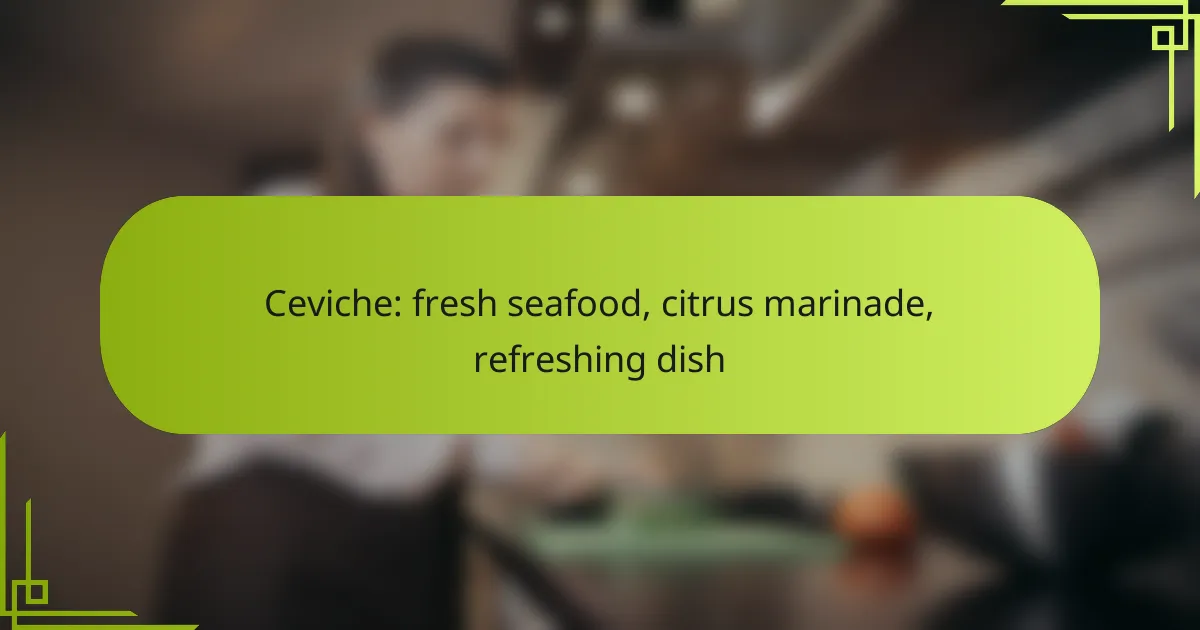Ratatouille is a classic French dish that celebrates the use of seasonal vegetables, showcasing the natural sweetness of ingredients like zucchini, eggplant, and bell peppers. By employing traditional French techniques such as sautéing and layering flavors, this rustic dish transforms simple produce into a comforting and hearty meal. Perfect for adapting to the changing seasons, Ratatouille embodies the essence of fresh, locally sourced produce.

How to prepare Ratatouille with seasonal vegetables in Canada?
To prepare Ratatouille with seasonal vegetables in Canada, focus on using fresh, locally sourced produce such as zucchini, eggplant, and bell peppers. This classic French dish highlights rustic flavors and can be adapted based on the vegetables available during different seasons.
Ingredients for Ratatouille
The key ingredients for Ratatouille include zucchini, eggplant, bell peppers, tomatoes, onions, and garlic. Fresh herbs like thyme and basil enhance the flavor, while olive oil is essential for sautéing the vegetables. Aim for organic produce when possible to maximize taste and quality.
In Canada, consider using seasonal vegetables, which may vary by region. For example, in summer, you can find an abundance of ripe tomatoes and zucchini, while fall may offer hearty root vegetables like carrots and squash.
Step-by-step cooking process
Start by washing and chopping all the vegetables into uniform pieces for even cooking. Heat olive oil in a large skillet or Dutch oven over medium heat, then sauté onions and garlic until fragrant. Add eggplant first, as it takes longer to cook, followed by zucchini, bell peppers, and finally tomatoes.
Cook the vegetables until they are tender, stirring occasionally. Season with salt, pepper, and fresh herbs. For a richer flavor, allow the Ratatouille to simmer for at least 20-30 minutes, letting the flavors meld together. Serve warm or at room temperature.
Common variations of Ratatouille
Ratatouille can be customized in various ways. Some recipes include additional vegetables like mushrooms or carrots, while others may incorporate spices such as paprika or cayenne for a kick. You can also blend the Ratatouille for a smoother texture or layer it with cheese for a gratin-style dish.
Another popular variation is Ratatouille Tian, where the vegetables are arranged in a visually appealing pattern and baked. This method not only enhances presentation but also allows the flavors to develop further during cooking.

What French techniques enhance Ratatouille?
French techniques that enhance Ratatouille include sautéing vegetables and layering flavors. These methods bring out the natural sweetness and depth of seasonal vegetables, creating a dish that is both rustic and sophisticated.
Sautéing vegetables
Sautéing is a fundamental technique in French cooking that involves cooking vegetables quickly in a small amount of fat over high heat. This method helps to caramelize the sugars in the vegetables, enhancing their flavor and texture. For Ratatouille, using a mix of olive oil and butter can add richness while allowing the vegetables to brown nicely.
When sautéing, it’s important to cut the vegetables into uniform sizes to ensure even cooking. Start with harder vegetables like eggplant and zucchini, then add softer ones like bell peppers and tomatoes later to prevent overcooking. Aim for a cooking time of around 5-10 minutes, stirring frequently to avoid burning.
Layering flavors
Layering flavors is essential in creating a well-balanced Ratatouille. This technique involves adding ingredients at different stages of cooking to build complexity. Begin with aromatics like onions and garlic, sautéing them until fragrant before introducing the other vegetables.
Consider using fresh herbs such as thyme or basil throughout the cooking process. Adding them at different intervals—some at the beginning and some towards the end—can provide a fresh burst of flavor. A splash of balsamic vinegar or a sprinkle of salt can also enhance the overall taste, making the dish more vibrant.

What are the rustic flavors of Ratatouille?
The rustic flavors of Ratatouille stem from its use of seasonal vegetables and traditional French cooking techniques. This dish highlights the natural sweetness and earthiness of ingredients like eggplant, zucchini, and bell peppers, creating a comforting and hearty meal.
Herbs and spices used
Ratatouille is typically seasoned with a variety of herbs and spices that enhance its rustic profile. Commonly used herbs include thyme, basil, and parsley, which add freshness and depth to the dish. A touch of garlic and a hint of bay leaf can also be included to elevate the flavors.
When preparing Ratatouille, consider using dried herbs if fresh ones are unavailable. Dried herbs can still impart significant flavor, but use them in smaller quantities, as they are more concentrated. A good rule of thumb is to use one-third the amount of dried herbs compared to fresh.
Regional flavor profiles
The flavor profiles of Ratatouille can vary significantly depending on the region of France. In Provence, where the dish originates, you might find a heavier emphasis on olive oil and sun-drenched vegetables, reflecting the Mediterranean climate. This version often includes ingredients like black olives and capers for added complexity.
In contrast, variations from other regions may incorporate different local vegetables or spices. For example, in northern France, you might encounter Ratatouille with a touch of cream or cheese, giving it a richer texture. Regardless of the regional twist, the essence of Ratatouille remains rooted in its rustic, vegetable-forward approach.

How to choose the best seasonal vegetables for Ratatouille?
To choose the best seasonal vegetables for Ratatouille, focus on freshness and ripeness, as these factors significantly enhance the dish’s rustic flavors. Look for vegetables that are in season, as they tend to be more flavorful and affordable, making your Ratatouille vibrant and delicious.
Local farmers’ markets in Canada
Local farmers’ markets in Canada are excellent places to find fresh, seasonal vegetables for Ratatouille. These markets often feature produce that is harvested within days, ensuring peak flavor and nutrition. Popular markets include the St. Lawrence Market in Toronto and the Granville Island Public Market in Vancouver.
When visiting a farmers’ market, engage with the farmers to learn about their growing practices and the best vegetables for your dish. Seasonal offerings can vary by region, so it’s beneficial to ask for recommendations based on what’s currently available.
Seasonal vegetable guide
A seasonal vegetable guide can help you select the best produce for Ratatouille throughout the year. In spring, look for zucchini, asparagus, and bell peppers; summer brings eggplant, tomatoes, and fresh herbs; while fall offers root vegetables like carrots and squash.
In Canada, the growing season typically runs from late spring to early fall, so prioritize vegetables that are harvested during this time. When selecting vegetables, choose those that are firm, free of blemishes, and have vibrant colors to ensure the best taste and texture in your Ratatouille.

What are the health benefits of Ratatouille?
Ratatouille offers numerous health benefits primarily due to its rich combination of seasonal vegetables, which are packed with vitamins, minerals, and antioxidants. This dish supports a balanced diet and can contribute to overall wellness when incorporated into regular meals.
Nutritional value of vegetables
The vegetables used in ratatouille, such as zucchini, eggplant, bell peppers, and tomatoes, are low in calories but high in essential nutrients. For instance, tomatoes are a great source of vitamin C and lycopene, while eggplants provide fiber and antioxidants.
Incorporating a variety of vegetables not only enhances the flavor but also boosts the nutritional profile. Aim for a colorful mix, as different colors often indicate different nutrients, contributing to a well-rounded intake of vitamins and minerals.
Low-calorie meal option
Ratatouille is an excellent low-calorie meal option, making it suitable for those looking to maintain or lose weight. A typical serving contains around 100-150 calories, depending on the ingredients and cooking methods used.
To keep it low-calorie, focus on using minimal oil and avoid adding high-calorie ingredients like cheese or heavy sauces. Pairing ratatouille with whole grains or lean proteins can create a satisfying meal without excessive calories.

How to pair Ratatouille with other dishes?
Ratatouille pairs well with a variety of dishes, enhancing the meal with its rustic flavors and seasonal vegetables. Consider complementary sides and beverages that accentuate the dish’s French roots for a harmonious dining experience.
Best side dishes
When serving ratatouille, consider pairing it with crusty bread, which can soak up the flavorful juices. A simple green salad dressed with vinaigrette adds a refreshing contrast, while grilled meats or fish can provide a hearty balance. For a vegetarian option, serve it alongside polenta or quinoa for added texture and nutrition.
Wine pairings
Ratatouille is best complemented by light to medium-bodied wines that enhance its vegetable flavors. A classic choice is a chilled rosé from Provence, which mirrors the dish’s Mediterranean roots. Alternatively, a fruity red wine like Pinot Noir or a crisp white such as Sauvignon Blanc can also work well, providing a nice acidity to balance the dish’s richness.

What kitchen tools are essential for making Ratatouille?
To create a delicious Ratatouille, essential kitchen tools include quality cookware and specific utensils that facilitate the preparation and cooking process. Choosing the right tools can enhance the flavors and textures of this rustic French dish.
Recommended cookware
For Ratatouille, a heavy-bottomed pot or Dutch oven is ideal as it provides even heat distribution, which is crucial for slow-cooking the vegetables. A sauté pan can also be useful for browning ingredients before combining them.
Consider using a non-stick skillet for sautéing if you prefer easier cleanup. Additionally, a roasting pan can be handy if you choose to roast some of the vegetables for added depth of flavor.
Essential utensils
Key utensils for making Ratatouille include a sharp chef’s knife for chopping vegetables and a cutting board for safe preparation. A wooden spoon is essential for stirring and mixing the ingredients as they cook.
Measuring cups and spoons are useful for accurately adding herbs and spices, while a vegetable peeler can help with preparing ingredients like eggplant and zucchini. A ladle is also beneficial for serving the finished dish.

What are the best storage methods for Ratatouille?
The best storage methods for Ratatouille involve refrigeration and freezing to maintain its flavors and textures. Properly stored, Ratatouille can last several days in the fridge or several months in the freezer.
Refrigeration
To store Ratatouille in the refrigerator, allow it to cool to room temperature before transferring it to an airtight container. It can typically be kept in the fridge for about 3 to 5 days. Make sure to check for any signs of spoilage before consuming.
When reheating, do so gently on the stove or in the microwave to preserve the dish’s rustic flavors. Adding a splash of olive oil can help restore moisture and enhance taste.
Freezing
For longer storage, freezing Ratatouille is an excellent option. Portion it into freezer-safe containers or bags, leaving some space for expansion. Ratatouille can be frozen for up to 3 months without significant loss of quality.
To thaw, place it in the refrigerator overnight or use the microwave’s defrost setting. Reheat thoroughly before serving to ensure it reaches a safe temperature.
Tips for Best Results
When storing Ratatouille, avoid mixing it with other ingredients that may spoil faster, such as fresh herbs or dairy. Label containers with the date to keep track of freshness. For optimal flavor, consider adding fresh herbs or a drizzle of olive oil just before serving after reheating.
Do not refreeze previously frozen Ratatouille after it has been thawed, as this can affect its texture and taste. Instead, only thaw what you plan to consume to minimize waste.










